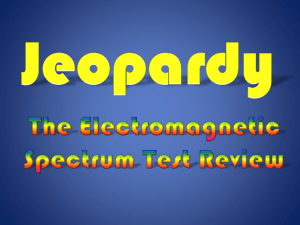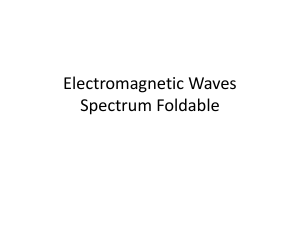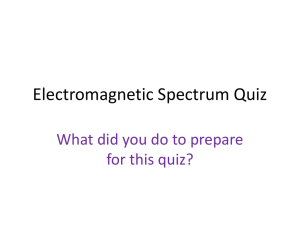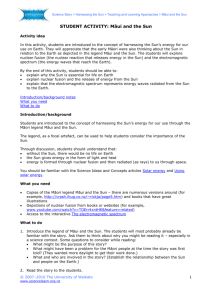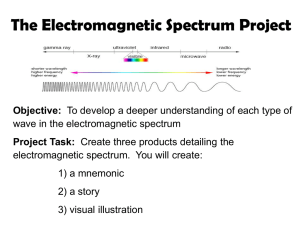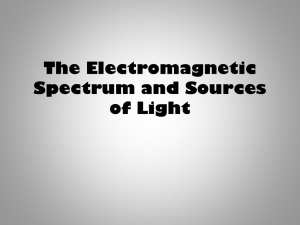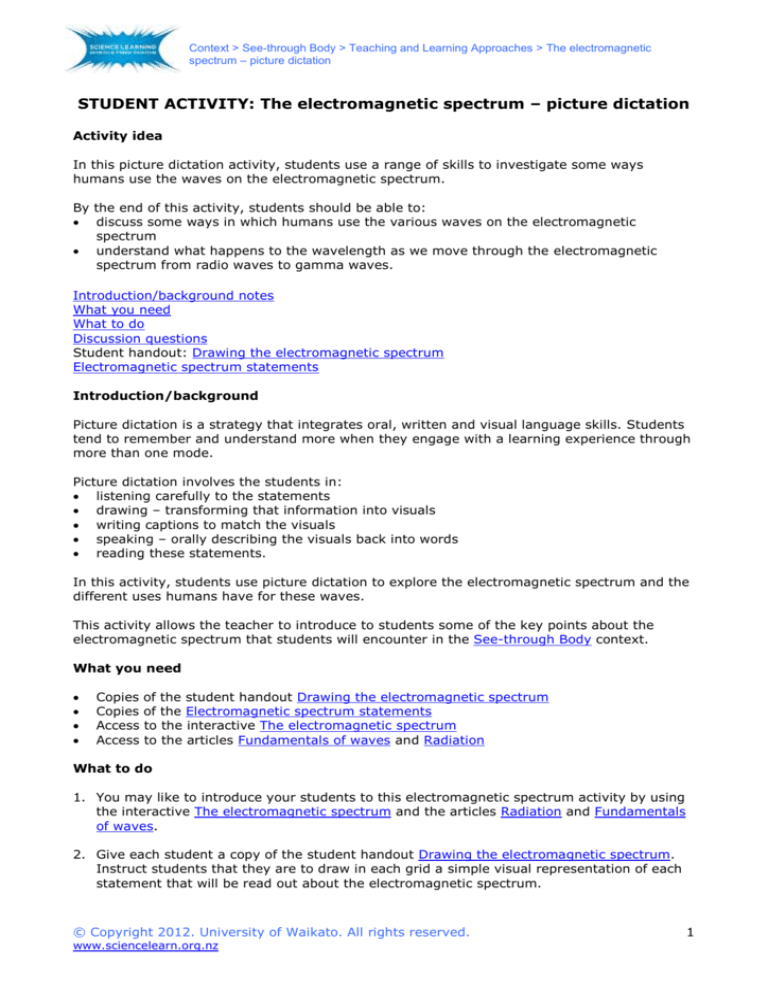
Context > See-through Body > Teaching and Learning Approaches > The electromagnetic
spectrum – picture dictation
STUDENT ACTIVITY: The electromagnetic spectrum – picture dictation
Activity idea
In this picture dictation activity, students use a range of skills to investigate some ways
humans use the waves on the electromagnetic spectrum.
By the end of this activity, students should be able to:
discuss some ways in which humans use the various waves on the electromagnetic
spectrum
understand what happens to the wavelength as we move through the electromagnetic
spectrum from radio waves to gamma waves.
Introduction/background notes
What you need
What to do
Discussion questions
Student handout: Drawing the electromagnetic spectrum
Electromagnetic spectrum statements
Introduction/background
Picture dictation is a strategy that integrates oral, written and visual language skills. Students
tend to remember and understand more when they engage with a learning experience through
more than one mode.
Picture dictation involves the students in:
listening carefully to the statements
drawing – transforming that information into visuals
writing captions to match the visuals
speaking – orally describing the visuals back into words
reading these statements.
In this activity, students use picture dictation to explore the electromagnetic spectrum and the
different uses humans have for these waves.
This activity allows the teacher to introduce to students some of the key points about the
electromagnetic spectrum that students will encounter in the See-through Body context.
What you need
Copies
Copies
Access
Access
of the student handout Drawing the electromagnetic spectrum
of the Electromagnetic spectrum statements
to the interactive The electromagnetic spectrum
to the articles Fundamentals of waves and Radiation
What to do
1. You may like to introduce your students to this electromagnetic spectrum activity by using
the interactive The electromagnetic spectrum and the articles Radiation and Fundamentals
of waves.
2. Give each student a copy of the student handout Drawing the electromagnetic spectrum.
Instruct students that they are to draw in each grid a simple visual representation of each
statement that will be read out about the electromagnetic spectrum.
© Copyright 2012. University of Waikato. All rights reserved.
www.sciencelearn.org.nz
1
Context > See-through Body > Teaching and Learning Approaches > The electromagnetic
spectrum – picture dictation
3. Read each of the seven electromagnetic spectrum statements to the class. Encourage the
students to listen carefully and to draw a simple picture that represents each statement in
the appropriate grid square. Allow enough time for the students to draw a visual
representation. Stress that the students’ visual images do not need to be works of art and
reassure them that the occasional word or number is OK.
4. After all seven statements have been read out, have students write a caption underneath
each visual.
5. Students then pair off and discuss what they understand about the electromagnetic
spectrum using their visuals and captions as prompts.
6. Students can be given a copy of the electromagnetic spectrum statements to read through
as they check their understanding of the electromagnetic spectrum.
Discussion questions
What is happening to the wavelength as we move through the electromagnetic spectrum,
from radio waves to gamma waves?
Electromagnetic waves carry energy. The shorter the wave, the more energy it carries.
Which has more energy – X-rays or microwaves?
© Copyright 2012. University of Waikato. All rights reserved.
www.sciencelearn.org.nz
2
Context > See-through Body > Teaching and Learning Approaches > The electromagnetic spectrum – picture dictation
Student handout: Drawing the electromagnetic spectrum
1
2
3
5
6
7
© Copyright 2012. University of Waikato. All rights reserved.
www.sciencelearn.org.nz
4
1
Context > See-through Body > Teaching and Learning Approaches > The electromagnetic
spectrum – picture dictation
Electromagnetic spectrum statements
1. Radio waves have the longest wavelengths – they range from 1 millimetre to 30 000
metres. Radio waves are used for radios, cellphones, televisions, Police radars and in
industry to melt materials such as plastics.
2. Microwaves have wavelengths ranging from 1 millimetre to 1 metre. They are used for heat
treatment therapy, alarm systems and heating food.
3. Infrared radiation wavelengths range from 750 nanometres to 1 millimetre. (A nanometre
is 1 billionth of a metre.) Infrared radiation is usually described as heat. The most
important source of infrared radiation is the Sun, although most heating appliances in your
home will emit infrared radiation too. Remote controls have an infrared source, and your
TV has a detector.
4. Visible light has wavelengths ranging from 400 to 770 nanometres. The most common form
of visible light also comes from the Sun. Other sources are light bulbs and lasers. Lasers
have lots of uses, for example, in CD players, pointers and laser eye surgery.
5. Ultraviolet light has wavelengths ranging from 300 to 400 nanometres. The main source of
UV radiation is the Sun, but it is also generated in industry. It’s used in sunbeds, dentistry,
detecting forged banknotes and treatment of skin conditions.
6. X-rays have wavelengths between 0.01 and 10 nanometres. They are used in medicine and
airport security. Doctors use them to look at bones, and dentists use them to look at teeth.
7. Gamma rays have the shortest wavelength at less than 0.01 nanometres. They are used in
medicine as a diagnostic tool and to sterilise equipment. They can be used in industry for
food irradiation, searching for oil, measurement of water and soil densities, and level
detectors, for example, making sure cans of food are filled to the correct level.
© Copyright 2012. University of Waikato. All rights reserved.
www.sciencelearn.org.nz
1


